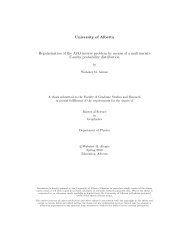Soner Bekleric Title of Thesis: Nonlinear Prediction via Volterra Ser
Soner Bekleric Title of Thesis: Nonlinear Prediction via Volterra Ser
Soner Bekleric Title of Thesis: Nonlinear Prediction via Volterra Ser
Create successful ePaper yourself
Turn your PDF publications into a flip-book with our unique Google optimized e-Paper software.
3.2. NONLINEAR MODELING OF TIME SERIES 34<br />
White<br />
Noise<br />
Sequence<br />
et<br />
crrr bqq ap c b2q c222 c221 b22 c b c112<br />
c111 b<br />
z<br />
+<br />
Σ<br />
Σ<br />
2rr a 2 1rr 1q 11 1<br />
−<br />
z<br />
a<br />
z<br />
xt<br />
AR<br />
Sequence<br />
Figure 3.3: <strong>Volterra</strong> AR diagram. Modified from Marple (1987) and Ulrych and<br />
Sacchi (2005). The coefficients <strong>of</strong> the linear term <strong>of</strong> the <strong>Volterra</strong> series are given by<br />
a1, · · · , ap, the coefficients <strong>of</strong> the quadratic term <strong>of</strong> the <strong>Volterra</strong> series are given by<br />
b11, · · · , bqq, and the coefficients <strong>of</strong> the cubic term <strong>of</strong> the <strong>Volterra</strong> series are given by<br />
c111, · · · , crrr.<br />
Equation (3.14) clearly states that I have more flexibility to model the deterministic<br />
part <strong>of</strong> the complex signal when the nonlinear terms are incorporated in the model.<br />
The third-order <strong>Volterra</strong> representation <strong>of</strong> the data requires the estimation <strong>of</strong><br />
p + q 2 + r 3 coefficients: ai, i = 1, . . . , p, bjk, j, k = 1, . . . , q, and clms, l, m, s =<br />
1, . . . , r. I will use symmetry properties <strong>of</strong> the <strong>Volterra</strong> series to reduce the number<br />
<strong>of</strong> coefficients <strong>of</strong> the quadratic contribution from q 2 to (q (q + 3)/2 − q) and the<br />
number <strong>of</strong> coefficients <strong>of</strong> the cubic contribution from r 3 to (r 2 + r!/(r − 3)!3!).<br />
Table 3.1 shows various filter lengths and the number <strong>of</strong> prediction coefficients<br />
using symmetry arguments <strong>of</strong> a <strong>Volterra</strong> series. It can be seen that the number <strong>of</strong><br />
parameters increases dramatically with a small increment in the filter order.<br />
Again, I can use forward and backward prediction<br />
x f p<br />
n = a<br />
i=1<br />
f<br />
q q<br />
i xn−i+ b<br />
j=1 k=1<br />
f<br />
jk xn−jxn−k+<br />
r r r<br />
l=1 m=1 s=1<br />
c f<br />
lms xn−lxn−mxn−s + εn , (3.15)









